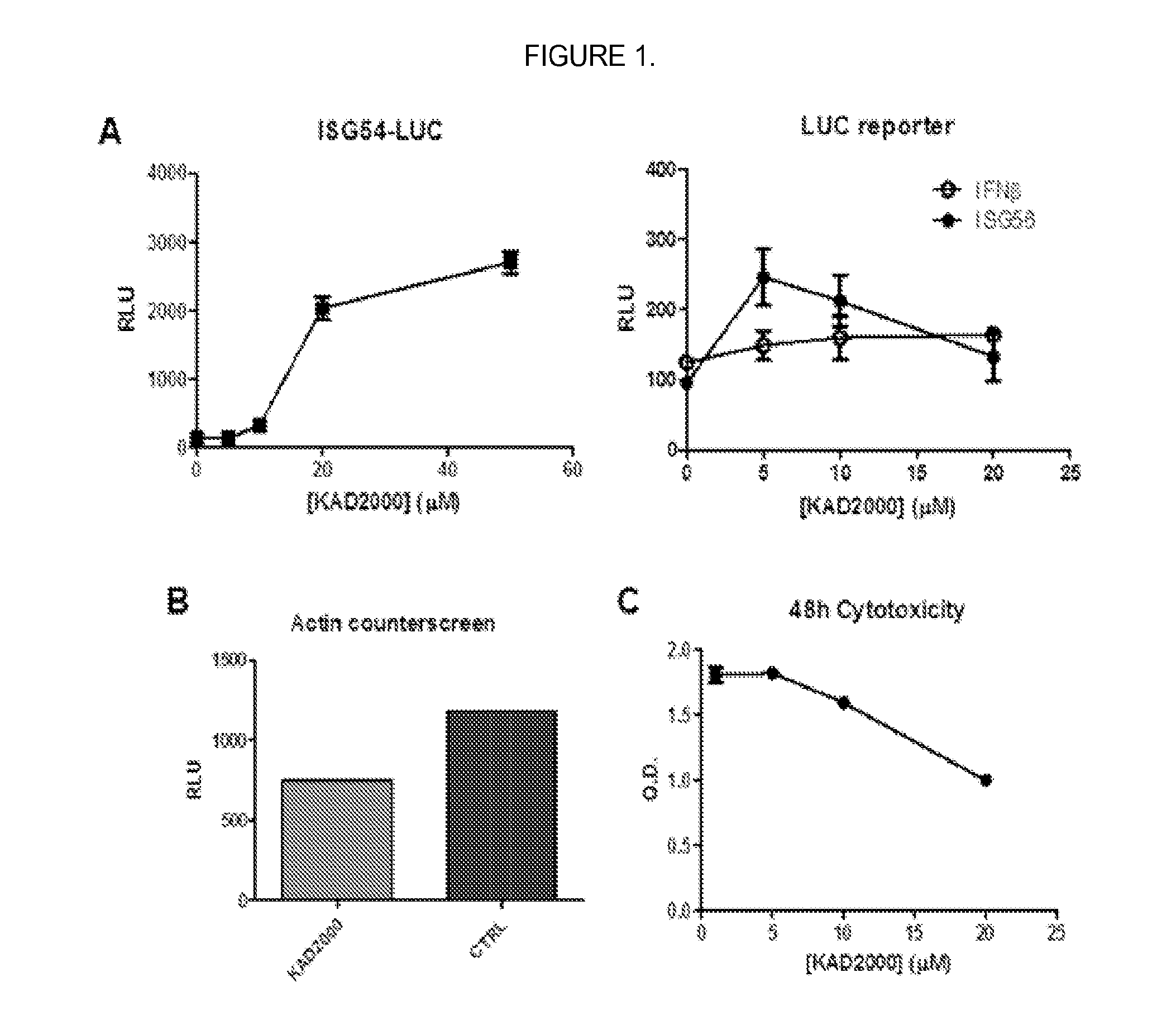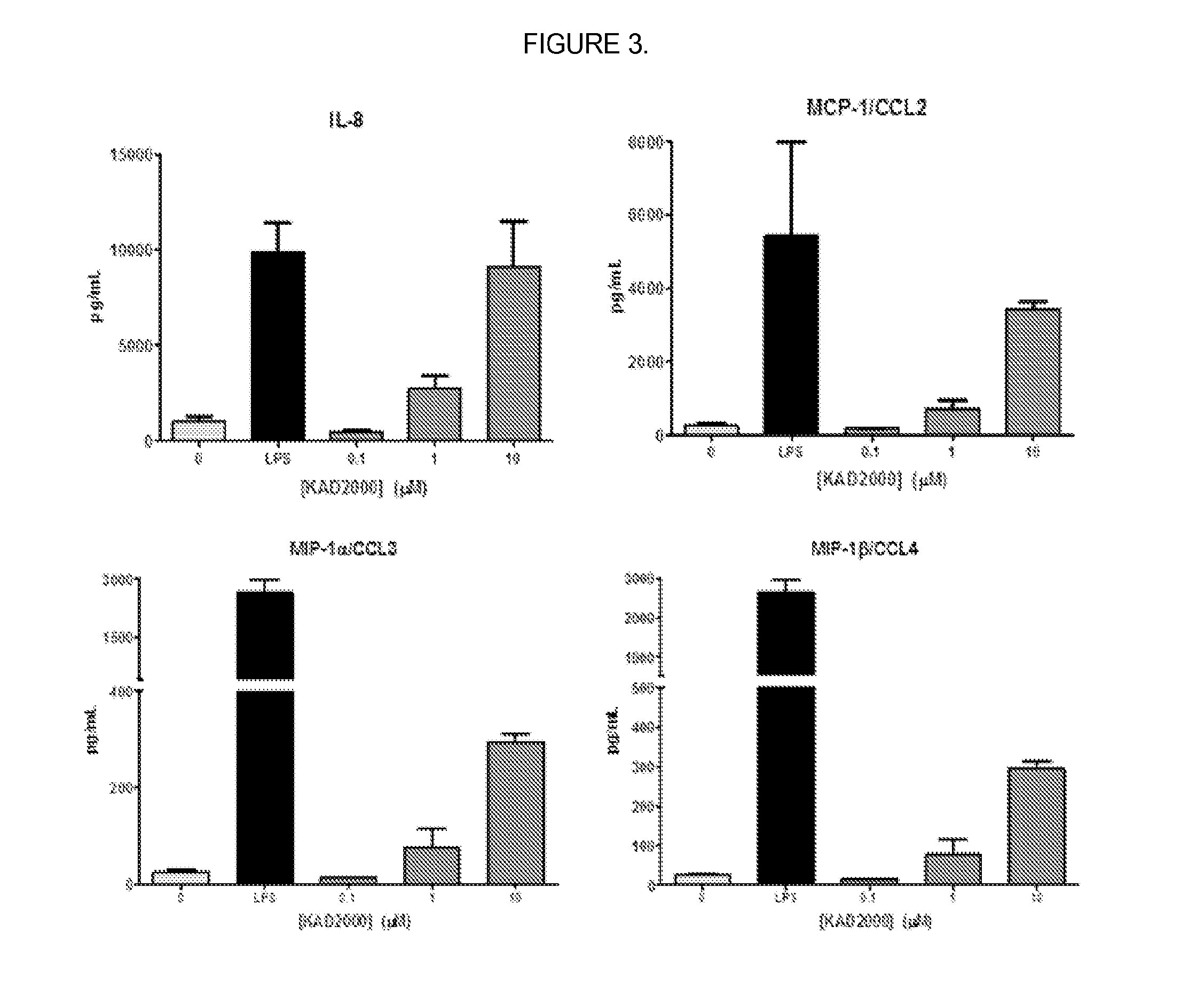Anti-viral compounds
- Summary
- Abstract
- Description
- Claims
- Application Information
AI Technical Summary
Benefits of technology
Problems solved by technology
Method used
Image
Examples
example 1
Biological Activity of KIN2000
[0089]Luciferase assay to identify active compounds. Cultured human cells that were stably transfected with luciferase reporter gene driven by RIG-I responsive promoter (IFNβ, ISG56, or ISG54 promoter) were seeded and allowed to grow overnight. The compound “KIN2000” was then added and cells were grown in the presence of KIN2000 for 18-20 hours. Steady-Glo luciferase substrate (Promega) was added and luminescence was read on a luminometer (Berthold).
[0090]FIG. 1A shows that KIN2000 as described herein was validated by demonstrating dose-dependent induction of luciferase reporter gene coupled to the promoters for IFNrβ and ISG56 (right; LUC reporter) and ISG54 (left; ISG54-LUC). Additionally KIN2000 did not induce a nonspecific promoter (FIG. 1B, Actin counterscreen).
[0091]MTS assay to determine cytotoxicity. Cultured human HeLa cells were treated with increasing amounts of compound or equivalent amounts of DMSO diluted in media for 48 hours to see their...
example 2
Ex Vivo Immune Stimulatory Activity of KIN2000
[0098]The activity of KIN2000 in primary immune cells was assayed to determine whether KIN2000 stimulates immune responses. In this example, cultured human primary dendritic cells were treated with 0, 1, or 10 μM of KIN2000 for 24 hours. Supernatant from treated wells was isolated and tested for levels of cytokine protein. Cytokines were detected using specific antibodies conjugated to magnetic beads and a secondary antibody that reacts with Streptavidin / Phycoerythrin to produce a fluorescent signal. The bound beads were detected and quantified using the MAGPIX® instrument (LUMINEX®) in this Example, but a similar technique can also be used to measure fluorescent protein production, such as an ELISA.
[0099]KIN2000 was shown to induce expression of chemokines by dendritic cells (IL-8, MCP-1, MIP-1α and MIP-1β, FIG. 3).
[0100]Other cells in which cytokine secretion can be measured include but are not limited to human peripheral blood mononuc...
example 3
Antiviral Activity and Pharmacological Properties Using Quantitative Structure-Activity Relationship (SAR) Studies
[0101]This Example describes optimization of compounds for antiviral action. First, a small analog derivative set is used to define structural class. The active analogs that are identified in this first stage are then used to define a subset of structural classes of interest for further optimization in (Stage 2).
[0102]Stage 2, derivative expansion. Stage 2 focuses on creating structural diversity and evaluating core variants. Structural derivatives are tested for biological activity in the IRF-3 translocation assay, antiviral activity against HCV and influenza virus, and cytotoxicity in one or more cell lines or peripheral blood mononuclear cells. Optimized molecules that show improved efficacy and low cytotoxicity are further characterized by additional measures of in vitro toxicology and absorption, distribution, metabolism, and elimination (ADME). Their mechanism of a...
PUM
| Property | Measurement | Unit |
|---|---|---|
| Composition | aaaaa | aaaaa |
| Immunogenicity | aaaaa | aaaaa |
Abstract
Description
Claims
Application Information
 Login to View More
Login to View More - R&D
- Intellectual Property
- Life Sciences
- Materials
- Tech Scout
- Unparalleled Data Quality
- Higher Quality Content
- 60% Fewer Hallucinations
Browse by: Latest US Patents, China's latest patents, Technical Efficacy Thesaurus, Application Domain, Technology Topic, Popular Technical Reports.
© 2025 PatSnap. All rights reserved.Legal|Privacy policy|Modern Slavery Act Transparency Statement|Sitemap|About US| Contact US: help@patsnap.com



